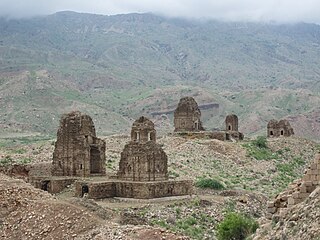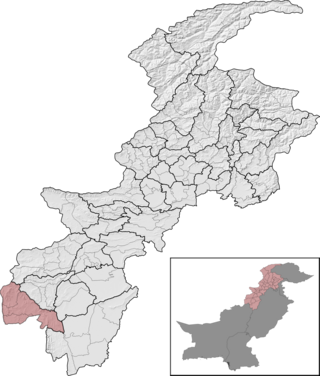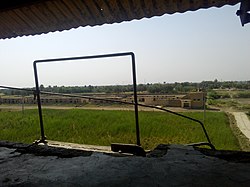
Dera Ismail Khan, abbreviated as D.I. Khan, is a city and capital of Dera Ismail Khan District, located in Khyber Pakhtunkhwa, Pakistan. It is the 10th largest city of Pakistan and third or fourth largest in the province of Khyber Pakhtunkhwa by population. Dera Ismail Khan is situated on the west bank of the Indus River, at its junction with the Gomal River.
Tank is the capital city of Tank District, Khyber Pakhtunkhwa, Pakistan. The city is located northwest of Dera Ismail Khan, and southeast of Jandola, Tank Subdivision. Lakki Marwat and Bannu lies to the northeast while South Waziristan lies to the west.

Bannu District is a district in the Bannu Division of the Khyber Pakhtunkhwa province of Pakistan. Its status as a district was formally recorded in 1861 during the British Raj.

Dera Ismail Khan District, often abbreviated as D.I. Khan is a district in the Dera Ismail Khan division of the Khyber Pakhtunkhwa province of Pakistan. The capital of the district is the town of Dera Ismail Khan. The district has an area of 9,334 km2 (3,604 sq mi) and a population of 1,822,916 as of the 2023 Census. After the Second Anglo-Sikh war in 1849 the district was annexed by the British as part of the Punjab and remained so until 1901 when NWFP Khyber Pakhtunkhwa was created.

Nowshera District is a district in the Peshawar Division of the Khyber Pakhtunkhwa province of Pakistan. The capital and district headquarter is Nowshera city.

Karak District is a district in Kohat Division of Khyber Pakhtunkhwa province in Pakistan. It is situated to the south of Kohat District and on the north side of Bannu and Lakki Marwat districts on the main Indus Highway between Peshawar and Karachi – it is 131 km from the provincial capital Peshawar. It gained a district status in 1982, prior to which it was part of Kohat District.

North Waziristan District is a district of Khyber Pakhtunkhwa province in Pakistan. It is the northern part of Waziristan, a mountainous region of northwest Pakistan, bordering Afghanistan and covering 4,707 square kilometres (1,817 sq mi). The capital city of North Waziristan is Miranshah.

Lakki Marwat or Lakki is the headquarters of Lakki Marwat District in Khyber Pakhtunkhwa province of Pakistan. Lakki Marwat has become one of the fastest growing cities in Khyber Pakhtunkhwa. Lakki Marwat is also the 20th most populous city in the province of Khyber Pakhtunkhwa.

Orakzai District is a district in the Kohat Division of the Khyber Pakhtunkhwa province of Pakistan. Before 1973, it was part of FR Kohat. Up until 2018, it was an agency within the erstwhile Federally Administered Tribal Areas. However, with the merger of the FATA with Khyber Pakhtunkhwa, it attained the status of a district.

Hangu District is a district within the Kohat Division of the Khyber Pakhtunkhwa. The district takes its name from the town of Hangu, which is its administrative centre. The name Hangu may also sometimes be applied to the Miranzai Valley which is partly within the district, bordering the Samana Range.
The Shirani, also spelled Sherani, are a Pashtun tribe, from the Sarbani tribal confederacy, who live in Afghanistan and Pakistan. The Sherani are mostly settled in the Frontier Region Dera Ismail Khan, in the Federally Administered Tribal Areas of Pakistan and in the adjoining Sherani District of Balochistan, Pakistan. Some clans have settled in other surrounding districts of Balochistan; and in the Zabul, Ghazni, and Kandahar provinces of Afghanistan.

Dera Ghazi Khan is a district in Punjab, Pakistan. Its administrative capital is Dera Ghazi Khan.

Lakki Marwat is a district in the Bannu Division of the Khyber Pakhtunkhwa province of Pakistan. It was created as an administrative district on July 1, 1992, prior to which it was a tehsil of Bannu District.

Swabi District is a district in the Mardan Division of the Khyber Pakhtunkhwa province in Pakistan. It lies between the Indus and Kabul Rivers. Before becoming a district in 1988, it was a tehsil within the Mardan District. 96% of the population speaks Pashto as their first language.

South Waziristan District was a district in the Dera Ismail Khan Division of the Khyber Pakhtunkhwa province of Pakistan, before splitting into the Lower South Waziristan District and the Upper South Waziristan District on 13 April 2022. It covers around 11,585 km2 (4,473 mi2). Waziristan is located in the southwest of Khyber Pakhtunkhwa. It is situated between two rivers, the Tochi River to the north and the Gomal River to the south. The region was an independent tribal territory from 1893, separated from both Afghanistan and the British-ruled empire in the subcontinent. Raiding the tribal areas was a constant problem for the British, requiring frequent punitive expeditions between 1860 and 1945. Troops of the British Raj coined a name for this region "Hell's Door Knocker" in recognition of the fearsome reputation of the local fighters and inhospitable terrain. The district headquarter of the South Waziristan district is Wanna. South Waziristan is divided into three administrative subdivisions of Ladha, Sarwakai, and Wanna. These three subdivisions are further divided into eight Tehsils: Ladha, Makin, Sararogha, Sarwakai, Tiarza, Wanna, Barmal, and Toi Khula.

Kohat District is a district in the Kohat Division of the Khyber Pakhtunkhwa province of Pakistan. Kohat city is its district capital.
Isakhel Tehsil, is an administrative subdivision (tehsil) of Mianwali District in the Punjab province of Pakistan. The city of Isakhel is the headquarters of the tehsil which is administratively subdivided into 3 Municipal Committees 13 Union Councils. It is located between 32° 30′ and 33° 14′ N. and 71° 7′ and 71° 44′ E., with an area of 678 square miles (1,760 km2) and contains the towns of Isakhel, Kammar Mushani and Kalabagh
Tank is a tehsil located in Tank District, Khyber Pakhtunkhwa, Pakistan.

Upper South Waziristan District is a district located in the Dera Ismail Khan Division of the Khyber Pakhtunkhwa province of Pakistan. The Upper South Waziristan District was established on 13 April 2022 when the South Waziristan District was bifurcated into Lower South Waziristan and Upper South Waziristan. Spinkai ragzai region was declared as its capital.

Lower South Waziristan District is adistrict located in the Dera Ismail Khan Division of the Khyber Pakhtunkhwa province of Pakistan. The Lower South Waziristan District was created in April 2022 after the South Waziristan District was bifurcated into Lower South Waziristan and Upper South Waziristan. Wana city serves as its capital and district headquarters.


















